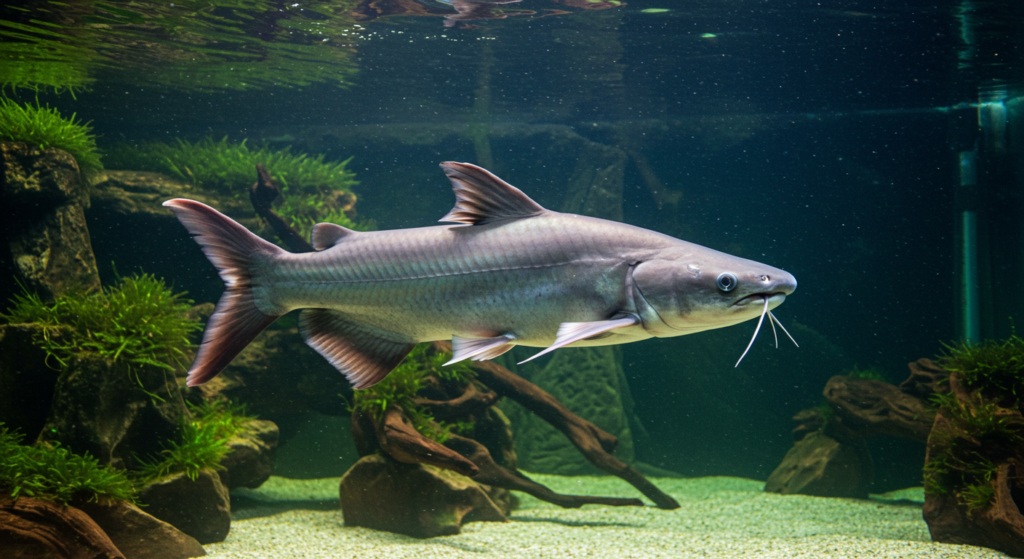Table of Contents
- Introduction
- Physical Characteristics
- Natural Habitat
- Tank Requirements
- Diet and Feeding
- Behavior and Temperament
- Common Health Issues
- Breeding Iridescent Sharks
- Conclusion
- FAQs
Introduction
The Iridescent Shark (Pangasianodon hypophthalmus), also known as the Striped Catfish or Sutchi Catfish, is a popular freshwater fish in the aquarium trade. Despite its name, it is not a true shark but rather a species of catfish native to Southeast Asia. Known for its sleek, silvery body and high-energy swimming, this fish requires specific care due to its large size and active nature.
This guide covers everything you need to know about keeping Iridescent Sharks, including their habitat, tank setup, diet, behavior, and common health concerns.

Physical Characteristics
The Iridescent Shark has a streamlined, torpedo-shaped body with a metallic silver-blue sheen. Key features include:
- Size: Can grow up to 4 feet (1.2 meters) in the wild, but typically reaches 12-24 inches (30-60 cm) in captivity.
- Coloration: Silvery-gray with a slight iridescent glow; juveniles have dark stripes that fade with age.
- Fins: Long dorsal and anal fins, with forked caudal fins resembling a shark’s tail.
Natural Habitat
Native to the Mekong and Chao Phraya River basins in Southeast Asia, these fish thrive in:
- Large, fast-flowing rivers
- Warm, tropical waters (75-82°F / 24-28°C)
- Slightly acidic to neutral pH (6.5-7.5)
- High oxygen levels
Tank Requirements
Due to their large size and active swimming habits, Iridescent Sharks need spacious tanks:
| Tank Parameter | Recommended Value |
|---|---|
| Minimum Tank Size | 300 gallons (for adults) |
| Water Temperature | 75-82°F (24-28°C) |
| pH Level | 6.5-7.5 |
| Water Hardness | 2-20 dGH |
| Filtration | Strong, efficient filtration (canister filters recommended) |
| Lighting | Moderate |
| Substrate | Sand or fine gravel |
Tank Setup Tips:
- Provide open swimming space with minimal decorations.
- Use driftwood or smooth rocks for hiding spots.
- Ensure a secure lid—these fish are strong jumpers.
Diet and Feeding
Iridescent Sharks are omnivorous and require a varied diet:
- High-quality pellets or flakes (sinking varieties preferred)
- Live or frozen foods (bloodworms, brine shrimp, daphnia)
- Vegetables (blanched zucchini, peas, spinach)
- Occasional protein sources (small fish, shrimp)
Feeding Frequency: 2-3 times daily in small portions.
Behavior and Temperament
- Active and fast swimmers, often seen darting around the tank.
- Shoaling species—best kept in groups of 3-5 (if tank size permits).
- Generally peaceful but may eat smaller tankmates.
- Sensitive to stress—avoid loud noises or sudden movements.
Common Health Issues
Like many large fish, Iridescent Sharks are prone to:
- Ich (White Spot Disease) – Treat with increased temperature and medication.
- Fin Rot – Caused by poor water quality; improve filtration and perform water changes.
- Bacterial Infections – Quarantine new fish and maintain clean water.
Breeding Iridescent Sharks
Breeding in captivity is extremely rare due to their size and migratory spawning behavior in the wild. Commercial breeding occurs in large ponds in Southeast Asia.
Conclusion
The Iridescent Shark is a fascinating but challenging fish to keep due to its massive size and active nature. While they are striking additions to large aquariums, they require ample space, strong filtration, and a balanced diet. If properly cared for, these fish can live 10-15 years in captivity.
FAQs
Q: Can Iridescent Sharks live with other fish?
A: Yes, but only with large, non-aggressive species like Oscars, Giant Gouramis, or other large catfish.
Q: How fast do Iridescent Sharks grow?
A: They grow rapidly, reaching 12 inches in the first year if well-fed.
Q: Are Iridescent Sharks aggressive?
A: No, they are peaceful but may accidentally swallow small fish.
Q: Do Iridescent Sharks need a heater?
A: Yes, they require tropical temperatures (75-82°F).
Q: Why is my Iridescent Shark hiding?
A: Stress, poor water conditions, or lack of hiding spots can cause this behavior. Check water parameters and reduce disturbances.
